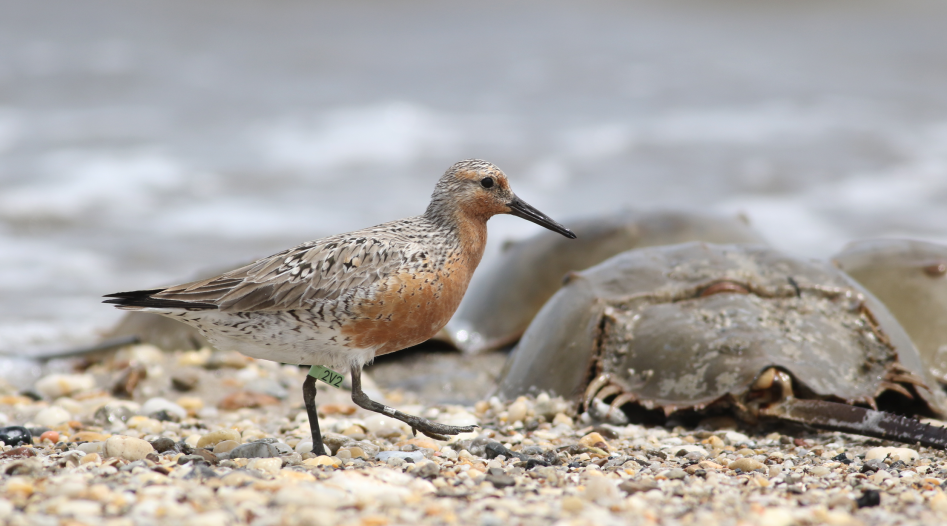In October, 2017, the Western Hemisphere Shorebird Reserve Network (WHSRN) Hemispheric Council voted unanimously to approve the designation of the Georgia Barrier Islands as a Landscape of Hemispheric Importance!
Shorebirds…. yet another chapter in the story of our ever changing planet. As temperatures rise, shorelines change, and habitats are lost in one location and gained in another, these winged globetrotters respond remarkably and adapt as they have throughout time. Unfortunately, their response to these changes is often interrupted by human interactions. Join biologists and birding experts from the Georgia Department of Natural Resources and the Sapelo NERR for the annual Shorebirds Conservation Teacher Workshop to explore who these birds are, the integral role the estuarine habitat plays in their migratory pathway between feeding and breeding grounds, as well as the many conservation and management efforts in place to ensure their continued survival. With Georgia’s estuarine habitat comprising nearly 400,000 acres of salt marsh, five major river systems, and a vast tidal range, we will boat to Egg Island for winter shorebird observations and invertebrate sampling. We will venture out to pristine stretches of Sapelo’s beach and marsh to observe feeding behaviors, and probe the sediments as the birds do to identify their food sources. You’re sure to depart on Sunday with an appreciation for the estuarine habitat and for these birds, in addition to a tote bag of classroom resources to educate your students in becoming good stewards of the earth! The Georgia Shorebirds Conservation Workshop is open to actively teaching formal and non-formal educators of all grade levels. Participants should be in good physical condition and able to walk approx. 1m. 2 PLU’s are available.
TOPICS INCLUDE: birding adaptations, migration, shorebird conservation, the importance of estuaries to humans and wildlife, and the intricate connections it has with the ocean and climate systems; corresponding activities from the USFW Shorebird Sister Schools Program and Estuaries 101
ACCOMODATIONS on Sapelo Island: dorm style facilities with 2 beds per room, central heat; transportation on Sapelo via open flatbed trucks with bench seating.
TIME: 5pm, Friday January 18- Sunday January 20, 4:30pm
COST: $215 includes meals, materials, island accommodations, & ferry
For questions please contact: Georgia Graves at georgiabeachwalk@gmail.com
To download a WORD file for registration click here.
To download a WORD file information and outline click here.
Shorebirds Conservation Teachers on the Estuary Teacher Workshop
Agenda Highlights
Day 1
4:30: arrive at Meridian Dock for ferry ride to Sapelo Island
5:30: Ferry departs for Sapelo, approx. 20 minutes to island, Pre-Test
6:30: Dinner and orientation NOAA/NERRS/SINERR history and overview of Georgia’s Estuarine Habitat
7:45: Introduction to shorebirds: Conservation, and Management strategies along the Georgia Coast Tim Keyes, GADNR Wildlife Biologist
Curriculum Activity: How To Build a Shorebird! : morphology & feeding characteristics for long distance migration and feeding strategies
Day 2
Breakfast
8:00: depart for boat excursion through Western Hemisphere Shorebird Reserve Network Regional habitat at the Atl Delta and to Egg Island
Exploration of Protected Shorebird Wintering and Stopover Sites: Tim & Georgia
Noon: Lunch
1:00 Tim Keyes: The Constraints of Flight: Anatomy and Physiology – Birds Inside and Out & The Freedom of Flight: Migration and Navigation
Break
Curriculum Activity: Shorebird Profiles
Afternoon low tide birding at Nannygoat sandy beach habitat to observe migratory shorebirds; we will also look at available food resources and how birds feed etc.
Free Time
6:15 Refreshments
7pm Dinner
8:15 Estuaries 101 Curriculum Overview: System Wide Monitoring Program (SWMP) Real-time data activity for classroom implication
Curriculum Activity: The Incredible Journey
Day 3
Breakfast
8:30: Shorebird Feeding Behaviors & Food Resources in the Estuarine Habitat, the “All You Can Eat Buffet” presentation with Georgia Curriculum Activity: What Do Tides Have To Do With It?
The three key habitats that shorebirds rely on for feeding will be addressed: the sandy beach, mud flat, and rocky shore habitats, along with invertebrates specific to each habitat and limiting factors for their survival.
Curriculum Activity “What Can I Eat With This Beak” Bird ID and Observations,
12:30 Lunch & pack up gear
1:30 load luggage and depart for SINERR lab for mud flat and “rocky shore” habitat sampling and invertebrate identification, Post Test
3:15 Depart for Ferry
4:00 Ferry Departs for mainland, farewells and safe trips home!

